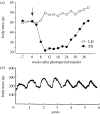Tracking the seasons: the internal calendars of vertebrates
- PMID: 17686736
- PMCID: PMC2606754
- DOI: 10.1098/rstb.2007.2143
Tracking the seasons: the internal calendars of vertebrates
Abstract
Animals have evolved many season-specific behavioural and physiological adaptations that allow them to both cope with and exploit the cyclic annual environment. Two classes of endogenous annual timekeeping mechanisms enable animals to track, anticipate and prepare for the seasons: a timer that measures an interval of several months and a clock that oscillates with a period of approximately a year. Here, we discuss the basic properties and biological substrates of these timekeeping mechanisms, as well as their reliance on, and encoding of environmental cues to accurately time seasonal events. While the separate classification of interval timers and circannual clocks has elucidated important differences in their underlying properties, comparative physiological investigations, especially those regarding seasonal prolactin secretions, hint at the possibility of common substrates.
Figures


References
-
- Almeida O.F, Lincoln G.A. Photoperiodic regulation of reproductive activity in the ram: evidence for the involvement of circadian rhythms in melatonin and prolactin secretion. Biol. Reprod. 1982;27:1062–1075. doi:10.1095/biolreprod27.5.1062 - DOI - PubMed
-
- Anderson G.M, Hardy S.L, Valent M, Billings H.J, Connors J.M, Goodman R.L. Evidence that thyroid hormones act in the ventromedial preoptic area and the premammillary region of the brain to allow the termination of the breeding season in the ewe. Endocrinology. 2003;144:2892–2901. doi:10.1210/en.2003-0322 - DOI - PubMed
-
- Badura L.L, Goldman B.D. Central sites mediating reproductive responses to melatonin in juvenile male Siberian hamsters. Brain Res. 1992;598:98–106. doi:10.1016/0006-8993(92)90172-6 - DOI - PubMed
-
- Baggerman B. Photoperiodic responses in the stickleback and their control by a daily rhythms of photosensitivity. Gen. Comp. Endocrinol. Suppl. 1972;3:466–476. doi:10.1016/0016-6480(72)90177-3 - DOI
Publication types
MeSH terms
Grants and funding
LinkOut - more resources
Full Text Sources

